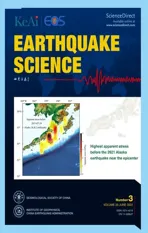Correlation between the tilt anomaly on the vertical pendulum at the Songpan station and the 2021 MS7.4 Maduo earthquake in Qinghai province,China
2022-11-03AnfuNiuZhengyiYuanJinWeiJingZhaoandWeiYan
Anfu Niu ,Zhengyi Yuan ,Jin Wei ,Jing Zhao and Wei Yan,✉
1 China Seismic Network Center, Beijing 100045, China
2 Institute of Seismology, China Earthquake Administration, Wuhan 430071, China
ABSTRACT Understanding the relationship between precursory deformation anomalies and strong earthquakes is vital for physical earthquake prediction.Six months before the 2021 MS7.4 Maduo earthquake in Qinghai province,China,the vertical pendulum at the Songpan station was observed to tilt southward with a high rate and large amplitude.Studies conducted before the 2021 MS7.4 Maduo earthquake inferred the tilt anomaly to be an earthquake precursor.However,after the earthquake,the relation between the earthquake and the anomaly became controversial,partly because the Songpan station is located at a great distance from the epicenter.In this study,based on the deformation anomaly characteristics,relationship between the seismogenic fault and the fault near the anomaly,and associated quantitative analyses,we concluded that this anomaly may be associated with the 2021 MS7.4 Maduo earthquake.The duration and amplitude of this anomaly matched with the magnitude and epicenter distance of the Maduo earthquake.We have also interpreted the reason why the anomaly occurred near a fault that is obliquely intersected with the seismogenic fault and why the anomaly is located far from the earthquake epicenter.
Keywords: 2021 MS7.4 Maduo earthquake;tilt of the vertical pendulum at the Songpan station;far-field correlation.
1.Introduction
Monitoring fault slips to predict earthquakes was first proposed in the 1960s based on the characteristics of coseismic and tectonic deformation.Many scholars believe that seismogenic faults exhibit a pre-slip before a large earthquake (Rice and Rudnicki,1979).However,even a relatively dense deformation-monitoring network (that measures tilt,strain,cross-fault leveling,etc.) may not reveal a significant deformation anomaly in the vicinity of a seismogenic fault in a short term before an earthquake(Bilham,2005;Johnston et al.,2006;Amoruso and Crescentini,2010).This phenomenon contradicts the theoretical earthquake rupture model (Rice and Rudnicki,1979;Fang ZJ et al.,2010).Therefore,short-term earthquake prediction by monitoring crustal deformation on seismogenic faults,as practiced in China,the United States,Japan,and Italy,is accompanied by considerable uncertainties (Bakun et al.,2005).Prior to the 2008MS8.0 Wenchuan earthquake and 2010MS7.0 Yushu earthquake,no apparent anomaly was detected at the deformationmonitoring stations in the epicentral regions (Niu AF,2017;Niu AF et al.,2021).Additionally,deformation anomalies have been observed in areas adjacent to active faults without subsequent strong earthquakes.This suggests that our current understanding of the relationship between precursory deformation and earthquakes is insufficient and needs to be further elucidated (Knopoff,1999).
In the absence of significant deformation near the epicenter before the earthquake,searching for source information from deformation at the periphery of the epicenter (field precursors),i.e.,inferring the source from the field,has been regarded as a viable method for earthquake prediction.However,determining the field precursors and their relationship with subsequent earthquakes is the main challenge that hinders the further development of this method.Previous studies have used static theory to identify earthquake precursors but have encountered various unexplained phenomena.
The 2021MS7.4 Maduo earthquake occurred in Qinghai province,China,with a left-lateral rupture of 1.8–2.9 m (Pan JW et al.,2021).It was the strongest earthquake in Chinese mainland after the 2008MS8.0 Wenchuan earthquake,and is being studied in detail (Hu MZ et al.,2021).The lack of monitoring stations within 200 km of the epicenter of this earthquake reduces the deformation monitoring capacity of the region.No significant anomaly was detected at the three deformation observation sites located 200–350 km away from the epicenter.Furthermore,the cross-fault baseline and leveling observations sites are distributed in the Qilian-Longmenshan-Xianshuihe seismic zone,400 km away from the epicenter.However,six months prior to the 2021MS7.4 Maduo earthquake,the vertical pendulum at the Songpan station had significantly tilted southward,with a high rate and large amplitude,and is believed to be a preearthquake anomaly.The Songpan station is~560 km away from the epicenter,and is not on the same fault or tectonic boundary as the earthquake.In this study,we introduce the concept of crustal stress waves to interpret the relation of the tilt anomaly observed at the Songpan station in Sichuan before the Maduo earthquake.Exploring the correlation between the tilt anomaly and the Maduo earthquake will aid in understanding the distribution pattern of pre-earthquake deformation anomalies and developing the concept of earthquake prediction.
2.Tilt of the vertical pendulum at the Songpan station
The Songpan station is located at the intersection of the northern and eastern boundaries of the Bayan Har tectonic block (Figure 1).This Bayan Har block is bounded by the East Kunlun fault (EKLF),a left-lateral strike-slip fault in the north and by the Longmenshan fault (LMSF) and Minjiang-Huya fault,which are strike-slip faults with thrust components,in the east.
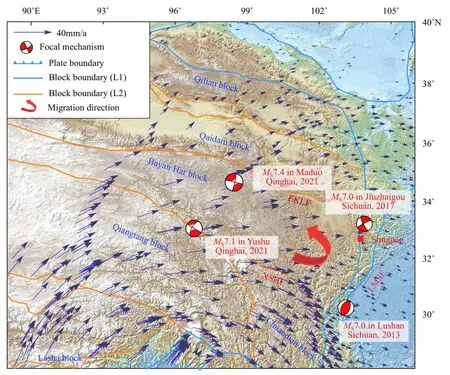
Figure 1.Location of the Songpan station and distribution of earthquakes with magnitude ≥7.0 since 2010.EKLF: East Kunlun fault;LMSF: Longmenshan fault;XSHF: Xianshuihe fault.
The vertical pendulum tiltmeter of the Songpan station is installed in an observation cave excavated in the mountain behind the office building of the station.The cave has a depth of 40 m,with seven thermal-insulating doors.The annual temperature difference inside the cave is<0.5°C.Instruments are installed in the relatively dry innermost cave chamber,which was previously a seismological observation room.
The ground tilt has been measured at the Songpan station since March 2013,with two components in the NS and EW directions being monitored.Each component is observed using a 153 mm long lead pendulum (the corresponding self-vibration period is 0.78 s).The pendulum systems are sealed in jars,which are fixed onto the same foundation pier.However,the observation quality was unstable owing to various factors related to the station,environment,and instrument;therefore,the obtaining of measurements was discontinued in March 2016 and resumed in November 2016 after a series of optimizations.The obtained data have been reliable since then and show clear tilt tides.In late September 2020,an anomaly began,when the long-term northward tilt shifted to an accelerated southward tilt and started to decelerate in late January 2021.Fisher statistic was constructed to quantify the intensity of the anomaly using tilt variations of 2018 as standard and a moving window with a time-step of one month (Niu AF et al.,1998).A result of <1.0 is considered normal,and a value >1.0 is regarded as an anomaly.Our results showed a significant anomaly from late September 2020 to late January 2021 (Figure 2) for a duration of~110 days.The tilting amplitude is~1 300 ms after tidal correction.The time between the end of this tilt anomaly to the occurrence of the Maduo earthquake was~3.5 months.
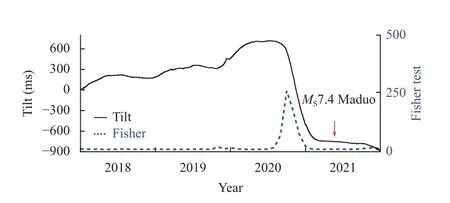
Figure 2.Variation curve of the southward tilt anomaly at the Songpan station and the results of the Fisher test.
As a response,the China Earthquake Administration had sent an expert team to the station on January 7,2021 to investigate this anomaly.They inspected the observation system and confirmed that the instruments were operating properly and showing clear tilt tide curves.Furthermore,no significant disturbances were observed in the recorded meteorological parameters,such as temperature,precipitation,and atmospheric pressure.The observation cave had undergone maintenance in mid-October 2020,after which no significant rate change was detected.It was finally concluded that the anomaly might be precursory.Moreover,even after the NS tilt anomaly had begun,variations in the EW tilt were normal.However,a colleague at the Sichuan Earthquake Administration accidentally touched the instrument jar that monitors the EW tilt component while investigating the NS tilt anomaly on October 22,2020.This disturbed the vertical pendulum,which started tilting westward;thus,the EW tilting data of this period is not reliable.
No apparent tilt anomaly was observed on the vertical pendulum at this station before the 2017MS7.0 Jiuzhaigou earthquake (epicenter distanceD=40 km).As mentioned in Section 1,this phenomenon can be partly explained by the locking effect of the seismogenic fault in the nearsource region before the earthquake.
3.Correlation between the tilt anomaly at the Songpan station and the 2021MS7.4 Maduo earthquake
Based on the deformation data of Chinese mainland since the 1980s,the precursory deformation anomalies are categorized into impending,short-term,and long-term,corresponding to a duration time of 1–4 days,15–180 days,and 1–3 years,respectively.Additionally,the time between the end of each type of precursory anomaly to the earthquake is 1 month,4 months,and 3 years,respectively.The current models describe the relationship between short-term deformation anomalies and earthquakes (Niu AF,2003,2017;Niu AF et al.,2020).
3.1.The Maduo earthquake occurred within the dominant seismic waiting time
The accelerated tilt anomaly at the Songpan station was a short-term anomaly,lasting for 110 days.The 2021MS7.4 Maduo earthquake occurred~3.5 months after the end of the southward tilt anomaly,i.e.,within the dominant seismic waiting time (Niu AF,2017).
Earthquakes usually occur under conditions of decelerated deformation anomalies (Niu AF et al.,2021).Right before the Maduo earthquake,the rate of the southward tilt anomaly had decreased dramatically,from~12 ms/d during the anomaly to~1 ms/d.
3.2.Duration of the anomaly matches the epicenter distance and earthquake magnitude
A method has been developed to identify the correlation between short-term deformation anomalies and earthquakes (Niu AF et al.,2020).In addition to constraining the time of occurrence of the earthquake,the relationship between the duration of the anomaly (T),epicenter distance (D),and magnitude of the earthquake(M0) are also constrained.We introduce the quantitative constraint model as follows:

whereD0=290 km,representing the half-wavelength of the long-period deformation wave or stress wave that can be obtained by characterizing deformation migration(Scholz,1977;Xu SX,2006;Niu AF et al.,2020).εfollows a normal distribution,with an expectationE(ε)=0 and the variance σ=0.28.
If the difference between the estimated value and the actual magnitude of the target earthquake is less than twice the σ,the precursory anomaly is considered to be correlated with the target earthquake with a 95% probability.
The duration of the southward tilt anomaly at the Songpan station was approximately 110 days,and its distance from the epicenter of the Maduo earthquake is approximately 560 km.According to Equation (1),the estimated magnitude of the target earthquake is 7.15.It differs by–0.25 from the actual magnitude,which falls within twice the σ of the model.Therefore,this tilt anomaly can be considered as related to the 2021MS7.4 Maduo earthquake with a 95% probability.
3.3.Amplitude of the tilt anomaly matches the M-D model
A model describing the relationship between the tilting amplitudeI(rad),D,andM0can be obtained based on the consistency between the amplitude of the short-term preearthquake accelerated tilt anomaly and the target earthquake (Niu AF,2003).

IfIis known,Equation (2) can be simplified as

whereC=1.14logI+11.87.Equation (3) describes the relationship betweenMandD,and is called theM-Dmodel.Dis a power function ofM,and does not have an extreme point or inflection point but can be used to examine the correlation between ground tilt anomalies and earthquakes.
The tilting amplitude recorded at the Songpan station was 1 300 ms,and its correspondingM-Dcurve is shown in Figure 3.The actualPpoint (for the magnitude of the Maduo earthquake and the distance from the epicenter to the Songpan station) lies close to theM-Dcurve,suggesting that the magnitude and epicenter distance of the Maduo earthquake correspond to the amplitude of the tilt anomaly at the Songpan station.
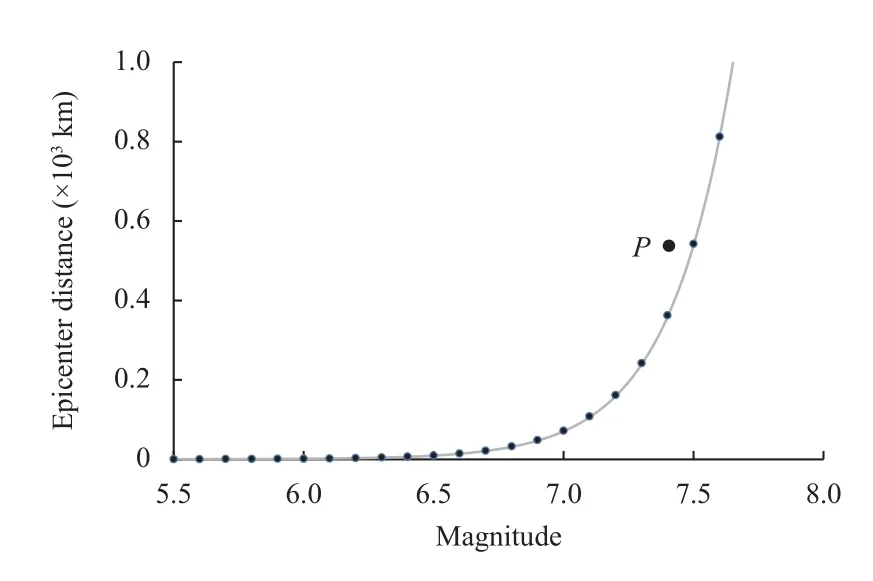
Figure 3.M-D model of the tilt anomaly and P-point correlation test for the Maduo earthquake.
4.Discussion on the correlation between far-field precursory deformation and earthquakes
4.1.Epicenter distance
Precursory deformation anomalies were believed to be caused by the anomalous activities of seismogenic faults.However,since the beginning of this century,several observations have shown that significant deformation anomalies are scarcely detected near earthquake epicenters owing to the fault locking effect (Bilham,2005;Johnston et al.,2006;Amoruso and Crescentini,2010).Furthermore,it has been observed that deformation anomalies generally do not occur at the periphery of the fault.Therefore,the causes of such pre-earthquake anomalies observed at great distances from the epicenter and their relation with the earthquake should be explored.
Crustal deformation is related to stress changes.Crustal stresses include in situ and transient stresses.In situ stresses,also known as static stresses or absolute stresses,are caused by long-term (geological) tectonic movements.Transient stresses,also called dynamic stresses,mainly originate from the rheology of deep materials and short-term interactions of crustal blocks.For instance,tectonic activities,such as earthquakes and volcanoes,can cause large changes in the crustal stress.Transient stresses fluctuate greatly and can be rapidly converted into transient strains; however,no clear relationship has been established between them.Slow earthquakes,with periods ranging from tens of seconds to hours and even days,and long-period deformation waves,with periods ranging from days to months,are both reflections of transient stress field variations (Scholz,1977;Feng DY et al.,1984).Co-seismic deformation,crustal tilt,strain,gravity field,and global navigation satellite systems (GNSS) are tools for observing transient stress field changes.Some deformation anomalies fluctuate spatiotemporally,indicating that the creep waves or crustal stress waves are generated by the migration of deep materials (Savage,1971;Bott and Dean,1973;Scholz,1977;Feng DY et al.,1984;Wang SJ and Yin ZS,1989;Niu AF et al.,1995;Niu AF,2017).
The Songpan station is~560 km away from the epicenter of the 2021MS7.4 Maduo earthquake.Because of the long distance,the tilt anomaly at this station was not considered associated with the Maduo earthquake based on the view that earthquake precursors are caused by the activity of seismogenic faults.However,new insights were obtained from the migration pattern of deep materials.The distribution of gravity anomalies and lowQ-values can be used to estimate the migration trend of subsurface materials to a certain extent.The gravity anomaly map for the study area shows that in the last five years,large-scale positive (or negative) anomalies,extending >600 km,have occurred within the Bayan Har block,which is conducive to the migration of deep materials in the block (Figure 4).Both the Maduo earthquake and the Songpan station are located within the Bayan Har block.The anomalous tilt deformation at the Songpan station and the Maduo earthquake may be related to such migration.The time differences between these two events reflects the role of precursory deformation in triggering earthquakes (Scholz,1977).TheQ-value distribution in the middle and upper crust,obtained by inversion using the 2.0-Hz band Lgwave data,also reveals a lowQ-value anomaly of >600 km long within the Bayan Har block (Figure 5) (Zhao LF et al.,2013).Owing to the flow of deep materials,interaction between the anomalous tilt deformation at the Songpan station and the Maduo earthquake may be relatively direct,despite the surficial distance between them.

Figure 4.Contour map of the gravity anomalies in the last 5 years (2016–2021).EKLF: East Kunlun fault;LMSF: Longmenshan fault;XSHF: Xianshuihe fault.
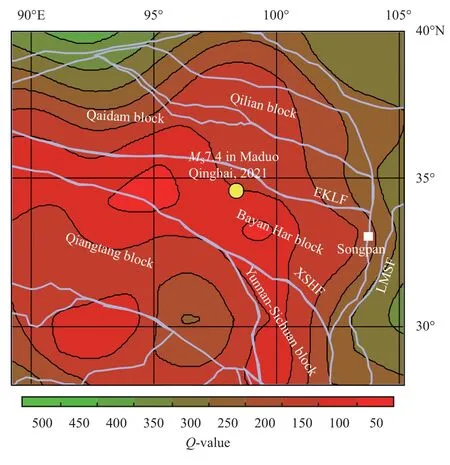
Figure 5.Distribution of the Q-value (Zhao LF et al.,2013)and the 2021 MS7.4 Maduo earthquake epicenter.Grey lines represent the boundaries of secondary blocks.EKLF: East Kunlun fault;LMSF: Longmenshan fault;XSHF: Xianshuihe fault.
4.2.Intersection of the deformation-related fault and the seismogenic fault
The 2021MS7.4 Maduo earthquake occurred on a fault near the northern boundary of the Bayan Har block that obliquely intersects the LMSF,on which the Songpan station is located.Experimental studies have confirmed the phenomena of oblique fault intersections (Ma J et al.,1999,2000,2002;Niu AF,2017),and we have attempted to explain them in new light.
With respect to crustal stress waves,both deformation migration and large-earthquake migration are results of subsurface material flow.Therefore,large-earthquake migration also supports deep-material migration.Four strong earthquakes of magnitude ≥7.0 occurred along the boundaries of the Bayan Har block after the 2008MS8.0 Wenchuan earthquake,i.e.,the 2010MS7.1 Yushu earthquake,2013MS7.0 Lushan earthquake,2017MS7.0 Jiuzhaigou earthquake,and 2021MS7.4 Maduo earthquake(present study).These four events occurred on the southern,eastern,and northern boundaries of the block(Figure 1),and were spatially distributed counterclockwise along the block boundaries at an interval of 3–4.3 years(Table 1).

Table 1.Migration of MS ≥7.0 earthquakes along the boundaries of the Bayan Har block since 2010.
The stage-wise migration of strong earthquakes around the Bayan Har block (Deng QD,2010) has occurred previously.During 1970–1976,a series of strong earthquakes occurred in the eastern Bayan Har and near the Yunnan-Sichuan blocks.TheMS7.6 Luhuo earthquake on February 6,1973,and twoMS7.2 Songpan earthquakes on August 16 and 23,1976,occurred in the eastern part of the block.The former is located on the Xianshuihe fault,and the latter on the Huya fault,with a counterclockwise distribution pattern along the boundaries of the Bayan Har block and an occurrence interval of~3.5 years.
The counterclockwise migration of strong earthquakes along the boundaries of the Bayan Har block reflects the direction of asthenospheric-material migration within it.Distribution of the GNSS displacement rate (Figure 1),which data form Wang M and Shen ZK (2020),demonstrates that the movement along the south of the Xianshuihe fault (XSHF) is predominantly clockwise,with a counterclockwise motion near the LMSF.Gravity results(Figure 4) show the distribution of large-scale positive(negative) anomalies within the block,which are favorable to the counterclockwise flow of deep materials in it.TheQ-value inversion results (Figure 5) reveal the distribution pattern of lowQ-values within the block,also indicating a counterclockwise migration trend near the LMSF.
The theory of crustal creep wave generation assumes(Savage,1971) that the fault at the bottom of the lithosphere is composed of a sequence of dislocation units.Shear stress generated because of the migration of asthenospheric materials causes absorption of the dislocation units or the aggregation of materials around a specific unit,and the latter leads to short-term accelerated deformation.When the materials accumulated around theunit are finally absorbed,i.e.,the accelerated deformation anomaly ends,the aggregated materials continue to migrate following the original direction or along the block boundary.Penetration of the fault at the bottom boundary reduces the probability of a major earthquake on it in the short term.Thus,faults where short-term deformation anomalies are observed are usually not seismogenic for large earthquakes.The creep wave model can also explain the deformation due to material flow in the middle and upper crust.The continued propagation of deep materials after reaching the fault intersection under shear stress and the mechanisms that trigger an earthquake near the obliquely intersecting faults need to be explored in future studies.
5.Conclusions
Owing to fault locking,the possibility of preearthquake deformation occurring near the epicenter is low.Therefore,the correlation between far-field deformation anomalies and earthquakes needs to be explored.We have obtained the following conclusions by quantitatively analyzing the tilt anomaly that occurred at the Songpan station before the 2021MS7.4 Maduo earthquake and discussing the related model.
(1) The duration and amplitude of the tilt anomaly at the Songpan station was consistent with the magnitude and epicenter distance of the Maduo earthquake.Based on the duration of the anomaly and the epicenter distance,the magnitude of the target earthquake was estimated to be 7.15,similar to the actual magnitude of the Maduo earthquake.The magnitude and epicenter distance of the Maduo earthquake conform to theM-Dmodel derived from the amplitude of the tilt anomaly.
(2) Geophysical field analysis revealed that the farfield correlation between the tilt anomaly at the Songpan station and the Maduo earthquake was related with the distribution of large-scale positive (negative) gravity anomalies and lowQ-values.Using the creep wave generation and propagation model proposed by Savage(1971),we discussed the cause of the short-term tilt variation at the Songpan station and the phenomenon whereby the fault near which the tilt anomaly was observed was obliquely intersected by the seismogenic fault.We believe that the blocking of deep-material migration may be a critical reason for the accelerated deformation.Additionally,the Maduo earthquake occurred on a fault that obliquely intersected with the Huya fault where the Songpan station is located.This observation is consistent with the counterclockwise migration trends of magnitude-7.0 earthquakes and deep materials along the boundaries of the Bayan Har block.
Acknowledgments
We sincerely thank the reviewers for their helpful comments on revising the manuscript.We thank Lianfeng Zhao,a researcher at the Institute of Geology and Geophysics,Chinese Academy of Sciences,for providing theQ-value data;Xuemei Zhang,a researcher at the Seismic Network Department of the China Earthquake Network Center,for assisting us in the research of seismic wave application;and Shengjie Lin,a research assistant at the Sichuan Earthquake Agency,for his help in the anomaly verification process.We would like to thank Editage (www.editage.cn) for English language editing.
杂志排行
Earthquake Science的其它文章
- Investigation on variations of apparent stress in the region in and around the rupture volume preceding the occurrence of the 2021 Alaska MW8.2 earthquake
- A comparative study of seismic tomography models of the Chinese continental lithosphere
- Emergence of non-extensive seismic magnitude-frequency distribution from a Bayesian framework
- Gorkha earthquake (MW7.8) and aftershock sequence:A fractal approach
